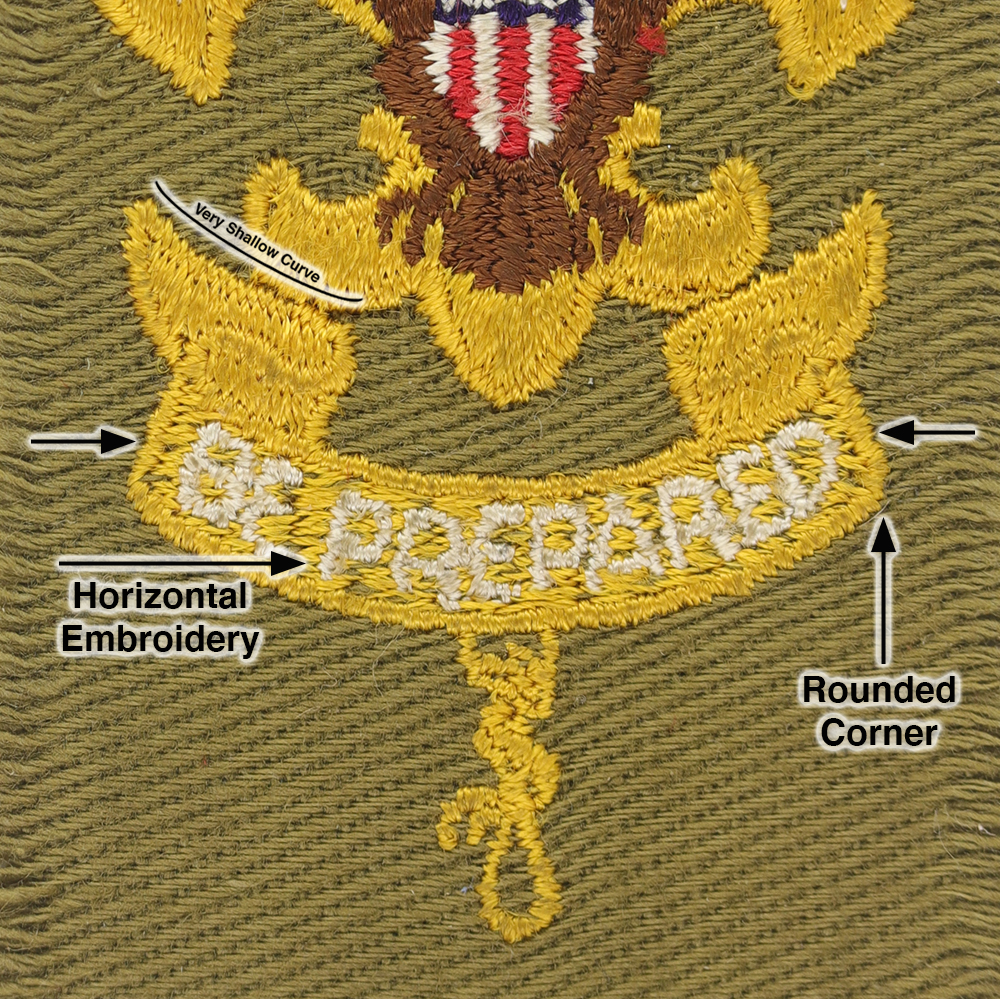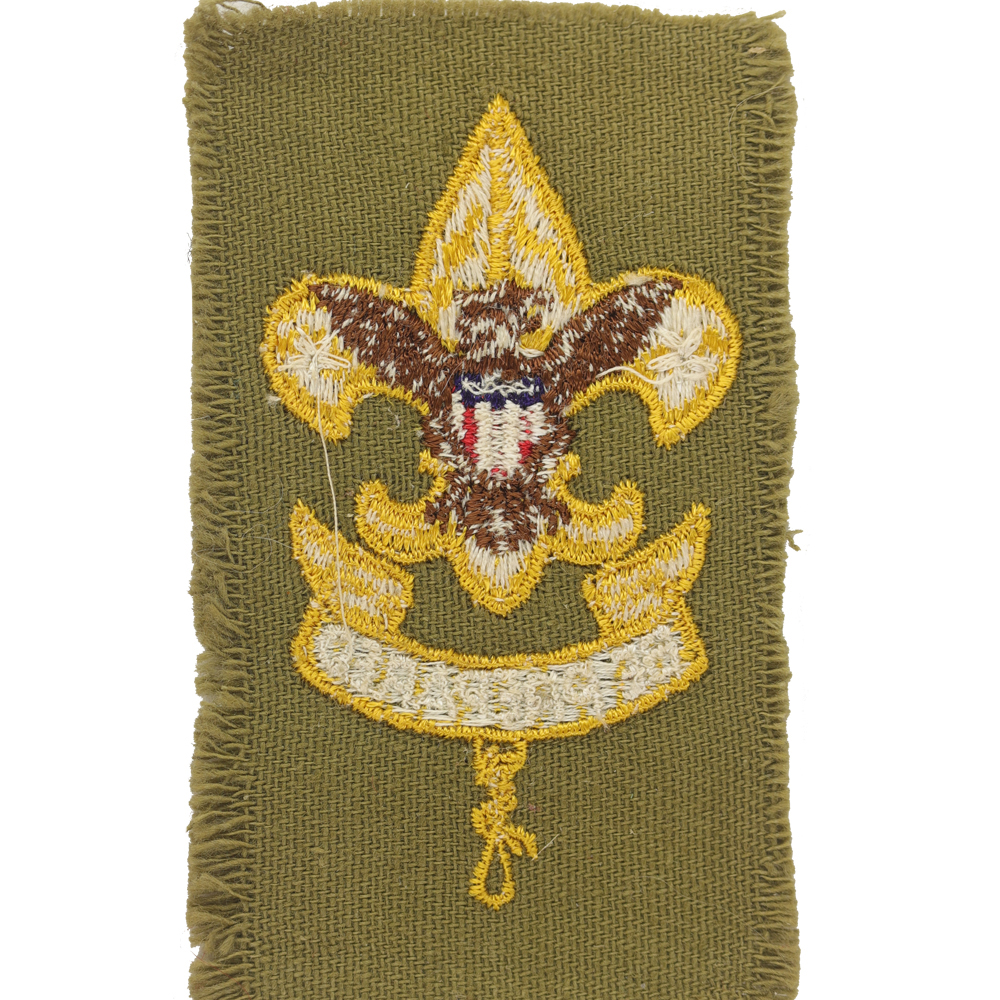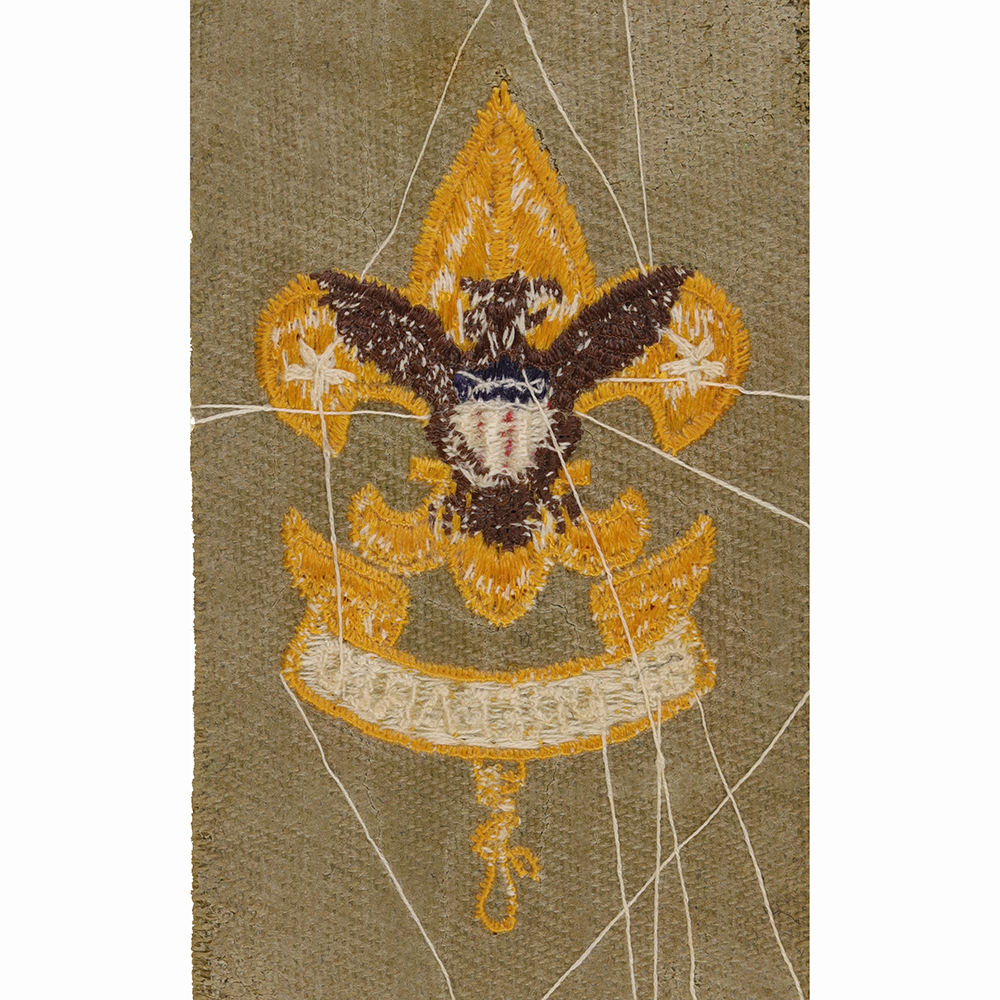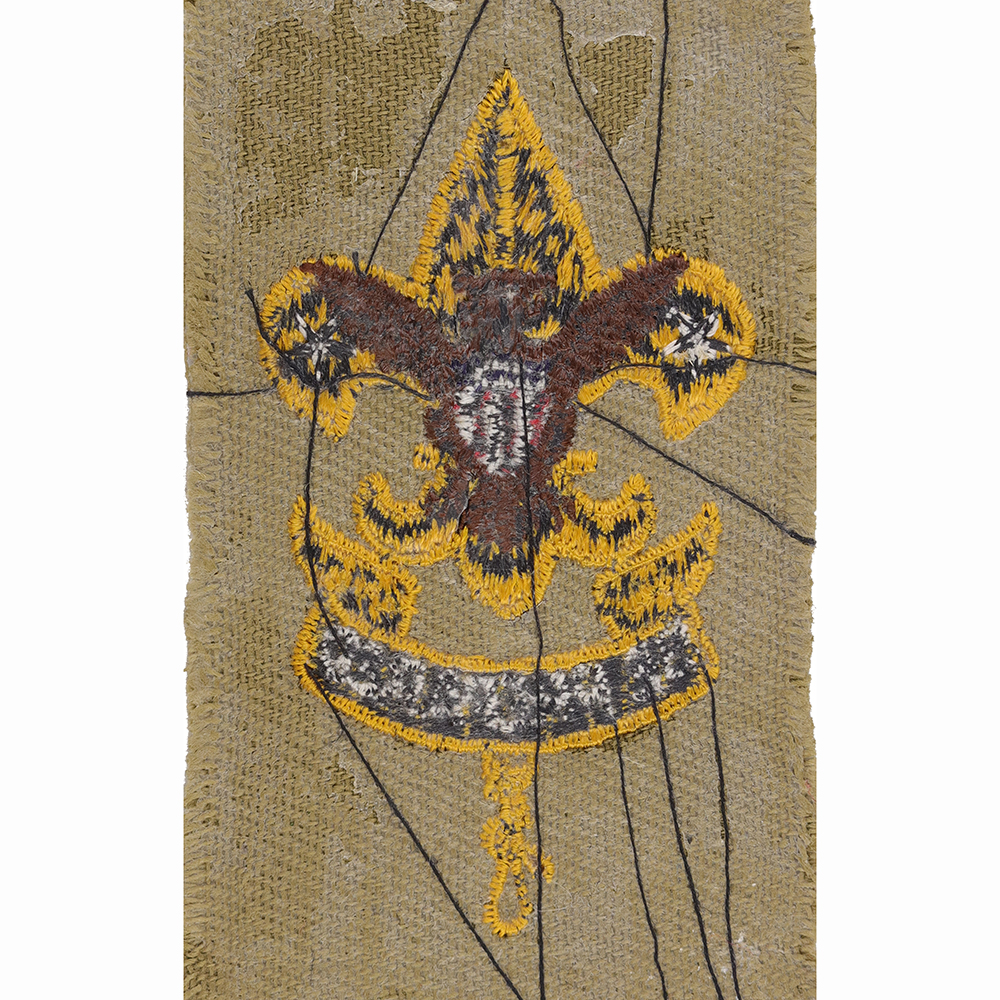Requirements November 1938 until December 1940
1. At least two months service as a Second Class Scout and be able to identify the rank, length of service and position of leadership of Scouts and local Scouters by means of their Badges and Insignia.
2. Swim fifty yards. (Jump overboard, feet first into deep water slightly over the head, swim twenty-five yards, make a sharp turn about, and return to the starting point.)
3. Earn and deposit at least $2 in a public bank or other savings institution (premiums paid on life insurance if earned, are accepted.), or plant, raise and market a farm crop or earn and contribute at least two dollars or the equivalent to the family budget or to welfare work in the community.
4. Send and receive a message by Semaphore, including conventional signs, thirty letters per minute, or by the General Service Code (International Morris), 16 letters per minute, including conventional signs; or by the Indian Sign Language code, thirty signs per minute; or by the Manual Alphabet for the Deaf thirty signs per minute.
5. Make a round-trip alone (or with another scout) to a point of at least seven miles away (fourteen miles in all), going on foot or rowing boat, and write a satisfactory account of the trip and things observed.
6. First Aid.
(a) Tell what First is and what are its limitations.
(b) Review second class first aid requirements.
(c) Show what to do for: (1) frost bitten foot; (2) snake bite on hand; (3) mad dog bite; (4) heat exhaustion and sunstroke, describing difference in appearance.
(d) Tell what to do for: (1) internal poising from food or drug; (2) freezing; (3) poisoning caused by poison ivy, poison sumac, or poison oak.
(e) Show how to: (1) use triangular bandage as sling and as directed for four of the following injuries – head, eye, hand, chest, hip, knee, foot. (in each case with dressing over wound); (2) apply splint to broken upper arm and place properly in cravat sling; (3) immobilize broken collar bone; (4) use neckerchief over shoe to support sprained ankle; (5) apply finger pressure (digital) to control arterial bleeding of wrist, ankle, and temple; (6) apply tourniquet on upper arm and upper leg at correct pressure points; and (7) control venous bleeding below knee.
(f) Explain necessity for immediate use of finger pressure control of bleeding; its advantages over tourniquet, and danger and necessary precautions in use of tourniquet.
(g) Demonstrate with another person: (1) four-hand carry and (2) blanket or coat-litter carry; (3) two-man carry with a chair; (4) with three other persons, method of lifting and transporting through a door and through a narrow passage a man who is unconscious, the Scout himself acting as captain of the team; (5) Fireman’s drag.
(h) Demonstrate symptoms of various degrees of shock, when to expect and how to deal with them.
7. Prepare and cook satisfactorily in the open, using camp cooking utensils, at least one of each of the following three classes of food, as may be directed: (1) Eggs and bacon, hunter’s stew, fish, fowl, or game; (2) pancakes, cornbread, biscuit, or a “twist”, baked on a stick; (3) oatmeal or other hot cooked cereal. Give an exact statement of the amount and cost of materials used and the number of persons intended to serve.
8. Read a map correctly, and draw, from field notes made on the spot and intelligible rough sketch map, including by their proper marks important buildings, roads, trolley lines, main landmarks, principal elevations, etc. Point out a compass direction without the help of the compass.
9. Use properly and ax for felling or trimming light timber; or produce an article of carpentry, cabinet-making, or metal work made by himself; or demonstrate repair of a decaying or damaged tree. Explain the method followed.
10. Judge distance, size, number, height, and weight within 25 per cent.
11. Be able to identify in the field (1a) 10 species of trees or plants, including Poison Ivy, noting such characteristic things as bark, leaves, flowers, fruit and scent; or (1b) 6 species of wild birds noting such characteristics as plumage, notes, tracks, and habits; or (1c) 6 species of native wild animals, noting characteristic form, color, call, track and habits. (2) Be able to point out the North Star, and be able to name and point out at least 3 constellations of stars.
12. Furnish satisfactory evidence that he has put into practice in his daily life the principles of the Scout Oath and Law.
Requirements December 1940 until December 1942
1. Have at least two months service as a Second Class Scout and be able to identify the rank, length of service and position of leadership of Scouts and local Scouters by means of their Badges and Insignia.
2. Swim fifty yards. (Jump overboard, feet first into deep water slightly over the head, swim twenty-five yards, make a sharp turn about, and return to the starting point.)
3. Earn and deposit at least $2 in a public bank or other savings institution (premiums paid on life insurance if earned, are accepted.), or plant, raise and market a farm crop or earn and contribute at least two dollars or the equivalent to the family budget or to welfare work in the community.
4. Send and receive a message by Semaphore, including conventional signs, thirty letters per minute, or by the General Service Code (International Morris), 16 letters per minute, including conventional signs; or by the Indian Sign Language code, thirty signs per minute; or by the Manual Alphabet for the Deaf thirty signs per minute.
5. Make a round-trip alone (or with another scout) to a point of at least seven miles away (fourteen miles in all), going on foot or rowing boat, and write a satisfactory account of the trip and things observed.
6. First Aid.
(a) Tell what First is and what are its limitations.
(b) Review second class first aid requirements.
(c) Show what to do for: (1) frost bitten foot; (2) snake bite on hand; (3) mad dog bite; (4) heat exhaustion and sunstroke, describing difference in appearance.
(d) Tell what to do for: (1) internal poising from food or drug; (2) freezing; (3) poisoning caused by poison ivy, poison sumac, or poison oak.
(e) Show how to: (1) use triangular bandage as sling and as directed for four of the following injuries – head, eye, hand, chest, hip, knee, foot. (in each case with dressing over wound); (2) apply splint to broken upper arm and place properly in cravat sling; (3) immobilize broken collar bone; (4) use neckerchief over shoe to support sprained ankle; (5) apply finger pressure (digital) to control arterial bleeding of wrist, ankle, and temple; (6) apply tourniquet on upper arm and upper leg at correct pressure points; and (7) control venous bleeding below knee.
(f) Explain necessity for immediate use of finger pressure control of bleeding; its advantages over tourniquet, and danger and necessary precautions in use of tourniquet.
(g) Demonstrate with another person: (1) four-hand carry and (2) blanket or coat-litter carry; (3) two-man carry with a chair; (4) with three other persons, method of lifting and transporting through a door and through a narrow passage a man who is unconscious, the Scout himself acting as captain of the team; (5) Fireman’s drag.
(h) Demonstrate symptoms of various degrees of shock, when to expect and how to deal with them.
7. Prepare and cook satisfactorily in the open, using camp cooking utensils, at least one of each of the following three classes of food, as may be directed: (1) Eggs and bacon, hunter’s stew, fish, fowl, or game; (2) pancakes, cornbread, biscuit, or a “twist”, baked on a stick; (3) oatmeal or other hot cooked cereal. Give an exact statement of the amount and cost of materials used and the number of persons intended to serve.
8. Read a map correctly, and draw, from field notes made on the spot and intelligible rough sketch map, including by their proper marks important buildings, roads, trolley lines, main landmarks, principal elevations, etc. Point out a compass direction without the help of the compass.
9. Use properly and ax for felling or trimming light timber; or produce an article of carpentry, cabinet-making, or metal work made by himself; or demonstrate repair of a decaying or damaged tree. Explain the method followed.
10. Judge distance, size, number, height, and weight within 25 per cent.
11. Be able to identify in the field (1a) 10 species of trees or plants, including Poison Ivy, noting such characteristic things as bark, leaves, flowers, fruit and scent; or (1b) 6 species of wild birds noting such characteristics as plumage, notes, tracks, and habits; or (1c) 6 species of native wild animals, noting characteristic form, color, call, track and habits. (2) Be able to point out the North Star, and be able to name and point out at least 3 constellations of stars.
12. Furnish satisfactory evidence that he has put into practice in his daily life the principles of the Scout Oath and Law.







